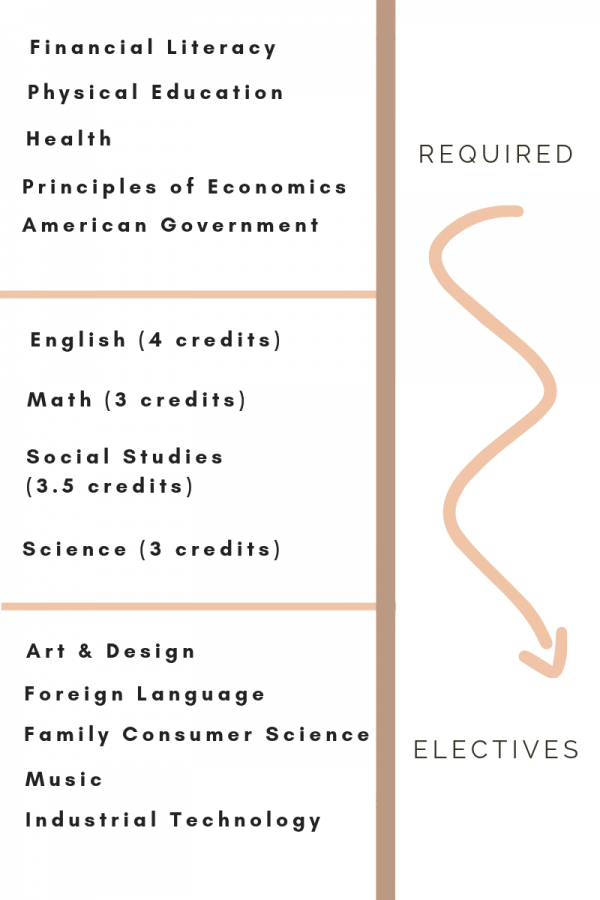The How and Why of Required Classes
May 23, 2019
For Mariana Arnold ’20, taking Health was just a repeat of previous health classes. “We’ve been learning Health since 5th grade. Everything we’ve learned is just a recap of what we’ve already learned,” Arnold said. However, Health class, while repetitive in nature, continues to be a required course for every Johnston student.
Of the 24 credits required for graduation, a number of credits come from specific, required classes. The required courses at Johnston High School vary greatly in content, but include classes such as Financial Literacy, taught by Kristine Volesky and Kayla Bousum, Health, taught by Jackie Sapp, American Government, and Principles of Economics, taught by Ben Knight and Patrick Hennes.
The Iowa Department of Education specifically adopted a policy establishing the requirements students must meet for graduation through a number of required courses. Specifically listed are American Government, Health, and Physical Education. “The main idea is that the State of Iowa has set up a required core curriculum that we have to have,” Knight said. “From the idea of what the state says, then we craft our classes.” Financial Literacy teacher, Kayla Bousum, finds room to personalize the required courses. “Within those standards, [the Financial Literacy teachers] have a lot of freedom to decide how to teach so that students reach the standards,” Bousum said.
Each class serves a different purpose. Health, usually taken in sophomore year, serves to teach students to develop a balanced, healthy life. The course covers nutrition, physical fitness, and substance abuse. Financial Literacy, usually taken in junior year, focuses on spending money wisely and saving & investing for students soon to make financial decisions. For those usually in senior year, American Government and Principles of Economics serve as the required social studies credits. Principles of Economics focuses on the economy at a national and international level, specifically on concepts like supply, demand, and trade balances, while American Government teaches students the fundamental characteristics of the American democracy.
Since economics was introduced as a required course, the enrollment size has jumped from 90 students to more than 400. The curriculum itself has also seen additions and modifications over the years. For example, in Health, a new focus has been placed on vaping as a health issue. “It has changed as health is an ever changing topic,” Sapp said.
In government, for instance, the curriculum also faces mild variations each year. “If it’s a caucus year, we put more emphasis on the political participation side of things,” Hennes said.
Oftentimes, the curriculum of required classes is not viewed as being particularly difficult. “I am totally okay with knowing I teach an ‘easy class’,” said Bousum. “I think it is easy, but the hard part is having the determination and focus to take the things you learn in Financial Literacy and applying as an adult to your personal finances.”
The level of difficulty of required classes is not hard, because student application of concepts is the ultimate goal. “Learning is about making connections to real life,” Volesky said.
Further in the future, the ability to pass the class might potentially increase further with the shift to standards-based grading. Allowing students to reassess any standard at any time and submit homework past the deadline might give anxiety-ridden students flexibility to earn their desired grades and pass the class easily. The results of this transition are yet to be seen.
Most believe that students do not hold required classes to the same importance as other classes, choosing instead to focus on more “difficult classes”. Suzy Brewer ’20 felt that required classes took up valuable time in her day. “I could have easily used the class period for any other class like AP Psychology or any other useful class,” Brewer said.
Student mentality heavily dictates student outcome. “Passing and failing lies in the hands of the student,” Sapp said. However, passing the class is required.
In the event that a student does not pass, credit recovery options are available. Those options must be discussed with counselors and administrators. Overall, the number of students failing required courses are small. “We’re not in the business to see how many students cannot pass a course,” Knight said. “That’s not the way it goes.”
Regardless of any negative stigma associated with required classes, a noticeable difference in student attitude in class is not seen. “The enthusiasm that we see is on par with most of the [students in] other classes,” Hennes said.
Instead, students often appreciate having the class be required. “I think everyone should have at least some experience [with these subjects], even if they don’t think it’s that important,” Arnold said.
The real gains from required classes are visible in the future when used in real-world applications. Applying the theoretical concepts learned in class is the ultimate goal of education. “What you get out of the class, is what you put into it,” Hennes said. “For any student that is willing to come to class, my guess is that they’ll find a way to be successful.”





